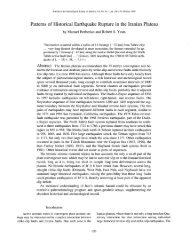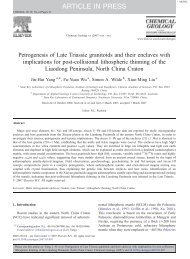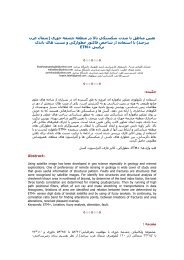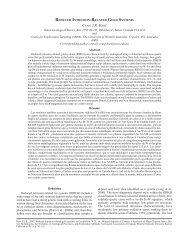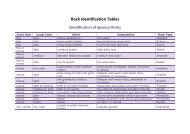Subevent analysis for the Tabas earthquake of September 16, 1978 ...
Subevent analysis for the Tabas earthquake of September 16, 1978 ...
Subevent analysis for the Tabas earthquake of September 16, 1978 ...
You also want an ePaper? Increase the reach of your titles
YUMPU automatically turns print PDFs into web optimized ePapers that Google loves.
6 I. Sarkar et al. / Physics <strong>of</strong> <strong>the</strong> Earth and Planetary Interiors xxx (2005) xxx–xxx<br />
recorded multiple arrivals; but on records <strong>of</strong> stations<br />
located at o<strong>the</strong>r azimuths, <strong>the</strong>se arrivals coalesced and<br />
could not be resolved well. Fur<strong>the</strong>r <strong>the</strong>y opined that <strong>the</strong><br />
strong motion data exhibited signatures <strong>of</strong> directivity<br />
to <strong>the</strong> northwest. Hartzell and Mendoza (1991) used a<br />
least square technique to simultaneously invert this near<br />
and far field data. Their numerical <strong>analysis</strong> indicated<br />
that rupture (a) occurred due to unilateral rupturing<br />
to <strong>the</strong> northwest, (b) as a multiple source event, with<br />
four main source regions over a fault length <strong>of</strong> 90 km.<br />
We may remark here that, as in o<strong>the</strong>r parts <strong>of</strong> <strong>the</strong><br />
world, where large <strong>earthquake</strong>s with complicated patterns<br />
<strong>of</strong> energy release have been found to be multiple<br />
events (e.g. Wyss and Brune, 1967; Kanamori and<br />
Stewart, <strong>1978</strong>), several large magnitude <strong>earthquake</strong>s<br />
occurring within <strong>the</strong> complex tectonics <strong>of</strong> <strong>the</strong> Iranian<br />
plateau are also in actuality multiple events (see <strong>for</strong><br />
example Campos et al., 1994; Sarkar et al., 2003).<br />
In this study we investigate <strong>the</strong> near field accelerograms<br />
from <strong>the</strong> <strong>Tabas</strong> <strong>earthquake</strong> recorded by a strong<br />
motion array installed in east-central Iran by Building<br />
and Housing Research Center, Iran. Our aim is to infer<br />
about <strong>the</strong> characteristics <strong>of</strong> <strong>the</strong> source and its rupture<br />
history as seen on near field ‘SH-wave’ accelerograms.<br />
We try to correlate <strong>the</strong> bursts <strong>of</strong> energy signatures on<br />
<strong>the</strong>se accelerograms in term <strong>of</strong> sub-events <strong>of</strong> <strong>the</strong> <strong>Tabas</strong><br />
<strong>earthquake</strong> and infer about <strong>the</strong>ir fault plane solutions,<br />
seismic moment, asperity size, seismic energy release<br />
and provide some insight into <strong>the</strong> scaling relations <strong>for</strong><br />
<strong>the</strong>se estimated parameters. We also estimate from accelerograms<br />
<strong>the</strong> average shear wave quality factors at<br />
<strong>the</strong> recording sites. We have employed near field ‘SHwaves’<br />
in our investigation because <strong>the</strong>se are minimally<br />
affected by <strong>the</strong> crustal heterogeneities (Haskell, 1960)<br />
and do not require any correction <strong>for</strong> mode conversion<br />
at <strong>the</strong> free earth surface. So we could adopt a<br />
half space representation <strong>for</strong> <strong>the</strong> <strong>earthquake</strong> source region<br />
during <strong>the</strong> ‘SH-wave’ data <strong>analysis</strong>. We note here<br />
that <strong>the</strong> approach followed here in this study, albeit<br />
very simplistic, has already been successfully applied<br />
in <strong>the</strong> <strong>analysis</strong> <strong>of</strong> two o<strong>the</strong>r <strong>earthquake</strong>s viz. <strong>the</strong> large<br />
(m b = 6.4, M S = 7.7, M w = 7.3) June 20, 1990 Rudbar<br />
<strong>earthquake</strong> <strong>of</strong> Iran (Sarkar et al., 2003) and <strong>the</strong> moderate<br />
(m b = 6.5, M S = 7.0, M w = 6.8) October 19, 1991,<br />
Uttarkashi <strong>earthquake</strong> <strong>of</strong> India (Kumar et al., 2005).<br />
For our investigation, we first rotate <strong>the</strong> observed<br />
horizontal component accelerograms appropriately to<br />
derive transverse component accelerograms. We assume<br />
here that <strong>the</strong>se approximately represent SH-wave<br />
accelerograms. We next identify <strong>the</strong> strong high frequency<br />
bursts <strong>of</strong> energy on <strong>the</strong>se ‘SH-wave’ accelerograms,<br />
as well as <strong>the</strong> corresponding impulsive strong<br />
phases on <strong>the</strong> counterpart velocity seismograms, as signatures<br />
<strong>of</strong> discrete sub-events. The sub-events are located<br />
using <strong>the</strong> ensemble <strong>of</strong> relative times from various<br />
recording sites with respect to a sub-event, whose location<br />
is assumed to be known (to be explained below).<br />
Our basis here is that a particular burst recorded at a station<br />
represents a new source <strong>of</strong> energy radiation from<br />
<strong>the</strong> related asperity (sub-fault) on <strong>the</strong> fault. We consider<br />
each strong phase available from those particular<br />
accelerograph stations that recorded it distinctly and assemble<br />
<strong>the</strong> set <strong>of</strong> such phase recordings <strong>for</strong> each <strong>of</strong> <strong>the</strong><br />
sub-events. Next we estimate <strong>the</strong> corresponding ‘SHwave’<br />
spectra, which is compensated <strong>for</strong> geometric divergence.<br />
On <strong>the</strong> ensemble <strong>of</strong> spectra <strong>of</strong> each sub-event,<br />
we conduct a non-linear least square inversion to obtain<br />
an average estimate <strong>of</strong> <strong>the</strong> strike, dip and slip <strong>of</strong> <strong>the</strong> corresponding<br />
rupture (Sarkar et al., 2003). The <strong>analysis</strong> is<br />
confined to <strong>the</strong> high fidelity band <strong>of</strong> <strong>the</strong> observed spectra.<br />
After suitably compensating <strong>the</strong> observed spectra<br />
<strong>for</strong> geometric divergence, inelastic attenuation and free<br />
surface effect, we fit appropriate Brune ω −2 models to<br />
<strong>the</strong> displacement spectra in <strong>the</strong> high fidelity range <strong>of</strong><br />
frequencies. The best fit Brune models allow to extrapolate<br />
<strong>the</strong> empirical spectra to frequencies outside <strong>the</strong><br />
recorded bandwidth and estimate appropriate values<br />
<strong>for</strong> (i) corner frequency and (ii) zero frequency spectral<br />
level and <strong>the</strong>reby <strong>the</strong> seismic moment, moment magnitude,<br />
asperity size, stress drop and shear wave energy<br />
released by <strong>the</strong> asperity. In this manner we have been<br />
able to estimate/infer (i) <strong>the</strong> locations <strong>of</strong> four/five asperities<br />
(sub-faults) associated with distinct phases <strong>of</strong><br />
energy release, (ii) <strong>the</strong>ir relative time <strong>of</strong> occurrence and<br />
(iii) <strong>the</strong> corresponding source parameters. We could use<br />
this corpus <strong>of</strong> in<strong>for</strong>mation to identify <strong>the</strong> localized imprints<br />
<strong>of</strong> <strong>the</strong> <strong>earthquake</strong> slip process and gain some<br />
insight into <strong>the</strong> details <strong>of</strong> <strong>the</strong> complex rupture process.<br />
2. Data set<br />
The strong motion array consists <strong>of</strong> 20 accelerograph<br />
stations installed within a radius <strong>of</strong> 300 km from<br />
<strong>Tabas</strong>. All <strong>the</strong> instruments are <strong>of</strong> SMA-1 type with a<br />
threshold <strong>of</strong> 10 gal. Although <strong>the</strong> array was fully oper-



